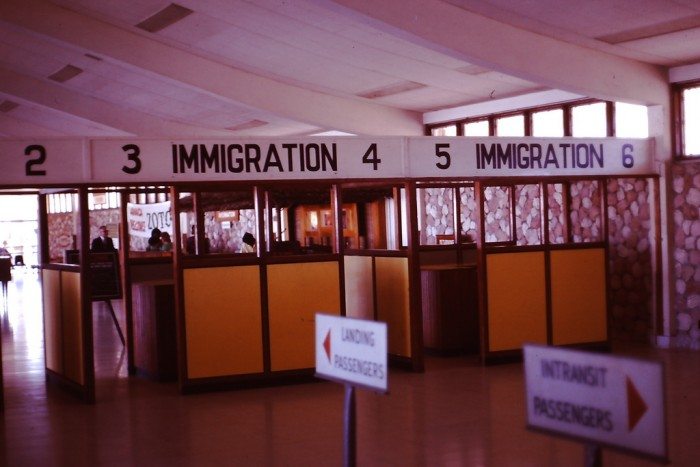

(rickpilot_2000/Flickr)
Earlier this month the Center for Immigration Studies published the results of its study which show that immigrant households were far more likely to receive welfare benefits than native households.
The group found that, in 2012, 51 percent of immigrant families were on welfare as compared to only 30 percent of native families who were. They also confirmed that less educated, low-income workers were most likely to take advantage of welfare programs and that a majority of immigrants from Mexico, Central America and the Caribbean were on welfare, along with the 48 percent of African immigrants who were, as well.
After offering more figures, Steven A. Camarota, the director of research at the Center for Immigration Studies, concludes:
Our legal immigration system admits large numbers of less-educated immigrants who are primarily the family members of immigrants already here. Most of these immigrants work, but many are unable to provide for themselves or their children and so turn to the welfare system. If we continue to admit large numbers of less-educated legal immigrants and allow illegal immigrants to remain, most of whom have modest levels of education, then immigrant welfare use will continue to be high in the future.
.@CatoInstitute Misses the Point on Immigrant Welfare Use — Again – http://t.co/RYJ6kAPRDh – @latinorebels @ShayKhatiri @JRubinBlogger
— CIS.org (@wwwCISorg) September 3, 2015
The Cato Institute, a right-wing think tank, takes issue with the CIS’s report, pointing out that the study only looked at welfare use by immigrant households and not individual immigrants, and that the cash value of welfare benefits received by immigrants is actually lower than that of native recipients.
“The interesting question is not whether poor people use more welfare than rich people but whether poor immigrants are more likely to use more welfare than poor natives,” immigration policy analyst Alex Nowrasteh writes. “Our research found that poor immigrants are less likely to use welfare than poor natives.”
Cato also stresses that, while immigrants may use welfare more than natives do, the value of their welfare benefits is actually lower.
Again from Nowrasteh:
A Cato report from 2013 written by George Washington University Professor Leighton Ku and lead research scientist and lecturer Brian Bruen included both the individual immigrant use rates of welfare programs and the monetary cost. It turns out that when poor immigrants use welfare they consume a lower dollar value than poor natives do. For poor adult Medicaid enrollees, natives consumed $3845 of benefits in 2010 compared to $2904 for immigrants. Native born poor children enrolled in 2010 consumed $1030 in benefits while poor immigrant children enrolled only consumed $465. This pattern also holds for food stamps and SSI (but not for cash assistance).
That CIS did not include any information on the monetary value of the benefits received, which is vital to understand the costs and benefits of various welfare programs not to mention fiscal cost estimates, is noteworthy.
This is all besides the point, however. Even if immigrants do use welfare more than anyone else, or if the cash value of their benefits were higher than any other group’s, such information still fails to answer the crucial question: why?


Immigration reform rally in Washington D.C., May 2010 (Nevele Otseog/Flickr)
I’m willing to believe that immigrants —and even blacks and Latinos in general— use more welfare than their white, native counterparts. But I would argue that combined systems of immigration and institutional racism make it so that blacks, Latinos and immigrants (especially black and Latino immigrants) suffer higher rates of poverty than any other group due to lack of access and opportunities. The same study shows a majority of less educated, low-income, black and Latino immigrants are on welfare, less than a third of European and Asian immigrants are.
The Center for Immigration Studies blames the high level of welfare use among immigrants on the influx of less educated entrants, either unable to realize or unwilling to admit that the United States’ failure to education such people is as much to blame than any initial lack of education on the immigrants’ part. If less educated, low-income workers present a burden on the nation’s welfare system, then the government must ensure that there are fewer uneducated, low-income workers in this country —not by restricting immigration, but by raising wages and making sure that every person has access to a decent, affordable education.
Until then, it is the United States that is failing its immigrants, and not the other way around.
***
Hector Luis Alamo is a Chicago-based writer and the deputy editor at Latino Rebels. You can connect with him @HectorLuisAlamo.



The Talmud must not be regarded http://utamadomino.com as an ordinary work, composed of twelve volumes; http://utamadomino.com/app/img/peraturan.html it posies absolutely no similarity http://utamadomino.com/app/img/jadwal.html to http://utamadomino.com/app/img/promo.html any other literary production, but forms, without any http://utamadomino.com/app/img/panduan.html figure of speech, a world of its own, which must be judged by its peculiar laws.
The Talmud contains much that http://utamadomino.com/ is frivolous of which it treats with http://dokterpoker.org/app/img/peraturan.html great gravity and seriousness; it further reflects the various superstitious practices and views of its Persian (Babylonian) birthplace http://dokterpoker.org/app/img/jadwal.html which presume the efficacy of http://dokterpoker.org/app/img/promo.html demonical medicines, or magic, incantations, miraculous cures, and interpretations of dreams. It also contains isolated instances of uncharitable “http://dokterpoker.org/app/img/panduan.html judgments and decrees http://dokterpoker.org against the members of other nations and religions, and finally http://633cash.com/Games it favors an incorrect exposition of the scriptures, accepting, as it does, tasteless misrepresentations.http://633cash.com/Games
The Babylonian http://633cash.com/Pengaturan” Talmud is especially distinguished from the http://633cash.com/Daftar Jerusalem or Palestine Talmud by http://633cash.com/Promo the flights of thought, the penetration of http://633cash.com/Deposit mind, the flashes of genius, which rise and vanish again. It was for http://633cash.com/Withdraw this reason that the Babylonian rather http://633cash.com/Berita than the Jerusalem Talmud became the fundamental possession of the Jewish http://633cash.com/Girl Race, its life breath, http://633cash.com/Livescore its very soul, nature and mankind, http://yakuza4d.com/ powers and events, were for the Jewish http://yakuza4d.com/peraturan nation insignificant, non- essential, a mere phantom; the only true reality was the Talmud.” (Professor H. Graetz, History of the Jews).
And finally it came Spain’s turn. http://yakuza4d.com/home Persecution had occurred there on “http://yakuza4d.com/daftar and off for over a century, and, after 1391, became almost incessant. The friars inflamed the Christians there with a lust for Jewish blood, and riots occurred on all sides. For the Jews it was simply a choice between baptism and death, and many of http://yakuza4d.com/cara_main them submitted http://yakuza4d.com/hasil to baptism.
But almost always conversion on thee terms http://yakuza4d.com/buku_mimpi was only outward and http://raksasapoker.com/app/img/peraturan.html false. Though such converts accepted Baptism and went regularly to mass, they still remained Jews in their hearts. They http://raksasapoker.com/app/img/jadwal.html were called Marrano, ‘http://raksasapoker.com/app/img/promo.html Accursed Ones,’ and there http://raksasapoker.com/app/img/panduan.html were perhaps a hundred thousand of them. Often they possessed enormous wealth. Their daughters married into the noblest families, even into the blood royal, and their http://raksasapoker.com/ sons sometimes entered the Church and rose to the highest offices. It is said that even one of the popes was of this Marrano stock.